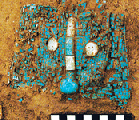| Art Q&A > Archeology > links |
|
|
Palatial site at Erlitou, Yanshi, Henan Province
In July 2004, archaeologists discovered the remains of a palace at Erlitou in Yanshi City of Central China's Henan Province. Palaces and walls as well as rammed-earth foundations have been excavated. Covering 108,000 square meters, the rectangular city is about 300 meters wide from east to west, and 360 meters long from north to south. In the palatial area, nine large-sized building sites have been dug up, with two groups of them revealing obvious axial lines. The ruined sites, with a history of more than 3,600 years, reportedly makes up the earliest palace ever found in China. The crisscross roads formed the transportation network in
the palace's central area. The palace, the large-scale Important relics, such as wheel tracks, large rammed earth bases, and the remains of turquoise-making workshops, were also found. The discovery of small-sized two-wheeled tracks pushed back the appearance of two-wheeled vehicles in China to as early as the Xia Dynasty.
In addition to the discovery of the said tracks, a large turquoise dragon
ware was excavated. The dragon, about 70 centimeters long and made up of
2000-odd various fine turquoises, is a rare dragon-designed antique in early
China in terms of scale, exquisiteness, and weight. |
||
All rights reserved. Reproduction of text for non-commercial purposes is permitted provided that both the source and author are acknowledged and a notifying email is sent to us. |
||
 |

 Site description
Site description

 Significance
Significance